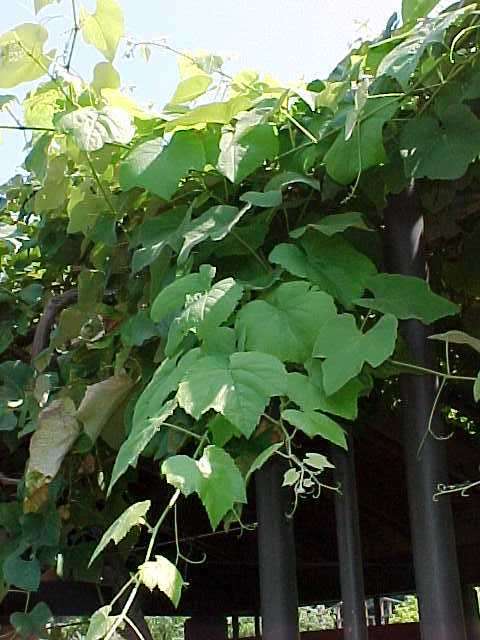Adaptations
There are adaptations that are true for all of the grapevines, but Vitis labrusca has also developed some of its own adaptations to be more successful than many of the other Vitis species.
General Adaptations of the Grapevine
Grapevines are climbing shrubs. They have specialized tendrils that make this possible. When found in the wild, they can climb all the way to the tops of trees. This is advantageous because it provides more surface area for the large leaves on the vine to be in the sun. The more sun a grapevine gets, the more sugar it can create out of the ultraviolet light from the sun and carbon dioxide from the atmosphere (Jump to Nutrition to see how this works). All of the excess sugar that the plant does not use for itself to live will be deposited into the grapes, giving them their sweetness. The amount a grapevine is able to photosynthesize is directly related to the quality of the fruit when they have ripened. This ability to climb may also be an adaptation to get off the ground in order to avoid frosts that are so detrimental to the fruit yield.
Adaptations Specific to Vitis labrusca
Vitis labrusca is one tough grapevine. Vitis vinifera
is the vine most commonly compared to Vitis labrusca because
vinifera was the grape of choice in Europe but when they colonized the
Americas, it was nowhere to be found and could not be grown successfully in
the eastern side of North America. Vitis labrusca has adaptations
that allow it to thrive in the somewhat harsher co nditions
that vinifera never encountered in Europe.
nditions
that vinifera never encountered in Europe.
Colder Climates: During the winter, shrubs and other woody perennials go into dormancy. During this dormant stage, there is a threshold temperature a plant can withstand. Plants are placed in zones based on their hardiness. Vitis labrusca is hardy to Zones 5 to 7, meaning it can withstand temperatures between 0 and -15 degrees Fahrenheit.
Resistance to Disease: Vitis labrusca has also demonstrated a higher resistance to certain diseases and pests than many other types of grapes, especially Vitis vinifera, the European grape. Some of these include Phylloxera vastatrix (Root louse), Japanese beetles, powdery mildew, and Botrytis cinerea (Gray Mold).
Root Louse: Phylloxera vastatrix is a tiny yellow aphid that likes to feed on the roots and leaves of vine plants. Once the plant that the bug is feeding on rots and dies, it moves on to the next host. This causes it to spread rather quickly. Root louse was only found in north America until it was accidentally transported to Europe in 1863 by Vitis labrusca plants. This caused an outbreak in the Vitis vinifera vineyards because the European grape had never been exposed to Phylloxera vasatrix and therefore had no resistance. This adaptation is what gave Vitis labrusca a chance to become commercially produced because the more popular Vitis vinifera could not be grown in the early colonies in north America.
Japanese Beetle: This pest is the most destructive insect pest in the eastern United States.4 This directly applies to the grapevine. The beetle will eat irregularly shaped holes in the leaves, leaving them with less surface area to photosynthesize with. Fortunately, Japanese beetles are not nearly as attracted to the Vitis labrusca leaves as they are to other grapevine leaves, such as Vitis vinifera.4 Labrusca has a coarser leaf compared to the thin glossy leaf of vinifera. This adaptation in leaf characteristics is what keeps Vitis labrusca out of the Japanese beetle's meal plan.
Powdery Mildew: Erysiphe necator is a fungus that very commonly infects grapevines, especially Vitis vinifera. It is native to north America, so Vitis labrusca yet again has some advantages over this European grape in adapted defenses against the fungus. These defense mechanisms include a thicker wax surface on the leaves or other penetration resistant factors and programmed cell death (PCD) responses.1
Orthotydeus lambi, a mite that likes to feed on fungus, is a very good solution to this powdery mildew problem. All types of grapes see a drastic decrease of infection when theses little bugs are around.3 Introducing these mites to grapevines in vineyards may be an option for controlling powdery mildew without chemical antifungal sprays.
Gray Mold: Botrytis cinerea is another disease that affects many grapevines and has an impact on the grape growing industry. Gray mold is particularly an issue because it can continue to grow at near freezing temperatures. This means it can continue to infest grapes even after the harvest. The only real natural defense against gray mold is physical penetration resistance. The thickness of the epidermis and the number of pores on the grapes are the factors that decide the resistance of this fungus.2 Vitis labrusca has that really thick "slip skin" with very few holes that keeps the gray mold at bay.
Pierce's Disease: This is one disease that Vitis labrusca does not have very much of a resistance to. To learn more about the disease caused by the bacteria Xylella fastidiosa, click here



